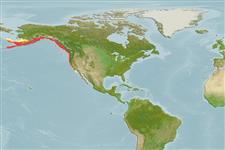Environment: milieu / climate zone / depth range / distribution range
Écologie
marin démersal; profondeur 18 - 425 m (Ref. 6793). Temperate
Northeast Pacific: Bristol Bay, Alaska to Unimak Island in the Aleutian chain and Point Montara, California, USA (Ref. 6793); extended to southeastern Bering Sea (Ref. 51659).
Taille / Poids / Âge
Maturity: Lm ? range ? - ? cm
Max length : 20.0 cm TL mâle / non sexé; (Ref. 2850)
Épines dorsales (Total): 8 - 9; Rayons mous dorsaux (Total): 6-9; Épines anales 0; Rayons mous anaux: 10 - 12; Vertèbres: 35 - 37. Dorsal fins touching or nearly so; caudal rounded; anal long based and rather low; pectorals broad, lower 4 to 6 rays thickened and not joined by membrane as far as their ends; pelvic fins reduced (in males, long pelvic fins reaching as far as the origin of the anal fin) (Ref. 6885). Dark gray or brown on upper surface, paler beneath, the line of demarcation very clear on head; some individuals with 6 or more dark saddle-shaped markings over back and extending on sides; dorsal fins with dark bands following free margins on fins; longitudinal dark coloring follows rays of caudal fin, especially at distal ends; rows of dark spots on rays of pectorals, and a bright orange spot in its center; dark spots on eyeballs more abundant on upper part (Ref. 6885).
Found on soft bottoms (Ref. 2850).
Life cycle and mating behavior
Maturité | Reproduction | Frai | Œufs | Fécondité | Larves
Eschmeyer, W.N., E.S. Herald and H. Hammann, 1983. A field guide to Pacific coast fishes of North America. Boston (MA, USA): Houghton Mifflin Company. xii+336 p. (Ref. 2850)
Statut dans la liste rouge de l'IUCN (Ref. 130435)
Menace pour l'homme
Harmless
Utilisations par l'homme
Plus d'informations
Noms communsSynonymesMétabolismePrédateursÉcotoxicologieReproductionMaturitéFraiRassemblement de ponteFéconditéŒufsDéveloppement de l'œuf
RéférencesAquacultureProfil d'aquacultureSouchesGénétiqueElectrophoresesHéritabilitéPathologiesTraitementNutrientsMass conversion
CollaborateursImagesStamps, Coins Misc.SonsCiguateraVitesseType de nageSurface branchialeOtolithesCerveauxVision
Outils
Articles particuliers
Télécharger en XML
Sources Internet
Estimates based on models
Preferred temperature (Ref.
123201): 2.9 - 8.6, mean 5.3 °C (based on 283 cells).
Phylogenetic diversity index (Ref.
82804): PD
50 = 1.0000 [Uniqueness, from 0.5 = low to 2.0 = high].
Bayesian length-weight: a=0.00389 (0.00180 - 0.00842), b=3.12 (2.94 - 3.30), in cm total length, based on all LWR estimates for this body shape (Ref.
93245).
Niveau trophique (Ref.
69278): 3.2 ±0.3 se; based on size and trophs of closest relatives
Résilience (Ref.
120179): Milieu, temps minimum de doublement de population : 1,4 à 4,4 années (Preliminary K or Fecundity.).
Fishing Vulnerability (Ref.
59153): Low vulnerability (10 of 100).
